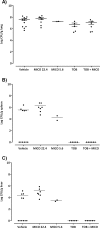Evaluation of combination therapy for Burkholderia cenocepacia lung infection in different in vitro and in vivo models
- PMID: 28248999
- PMCID: PMC5332113
- DOI: 10.1371/journal.pone.0172723
Evaluation of combination therapy for Burkholderia cenocepacia lung infection in different in vitro and in vivo models
Abstract
Burkholderia cenocepacia is an opportunistic pathogen responsible for life-threatening infections in cystic fibrosis patients. B. cenocepacia is extremely resistant towards antibiotics and therapy is complicated by its ability to form biofilms. We investigated the efficacy of an alternative antimicrobial strategy for B. cenocepacia lung infections using in vitro and in vivo models. A screening of the NIH Clinical Collection 1&2 was performed against B. cenocepacia biofilms formed in 96-well microtiter plates in the presence of tobramycin to identify repurposing candidates with potentiator activity. The efficacy of selected hits was evaluated in a three-dimensional (3D) organotypic human lung epithelial cell culture model. The in vivo effect was evaluated in the invertebrate Galleria mellonella and in a murine B. cenocepacia lung infection model. The screening resulted in 60 hits that potentiated the activity of tobramycin against B. cenocepacia biofilms, including four imidazoles of which econazole and miconazole were selected for further investigation. However, a potentiator effect was not observed in the 3D organotypic human lung epithelial cell culture model. Combination treatment was also not able to increase survival of infected G. mellonella. Also in mice, there was no added value for the combination treatment. Although potentiators of tobramycin with activity against biofilms of B. cenocepacia were identified in a repurposing screen, the in vitro activity could not be confirmed nor in a more sophisticated in vitro model, neither in vivo. This stresses the importance of validating hits resulting from in vitro studies in physiologically relevant model systems.
Conflict of interest statement
Figures





References
MeSH terms
Substances
LinkOut - more resources
Full Text Sources
Other Literature Sources
Molecular Biology Databases

